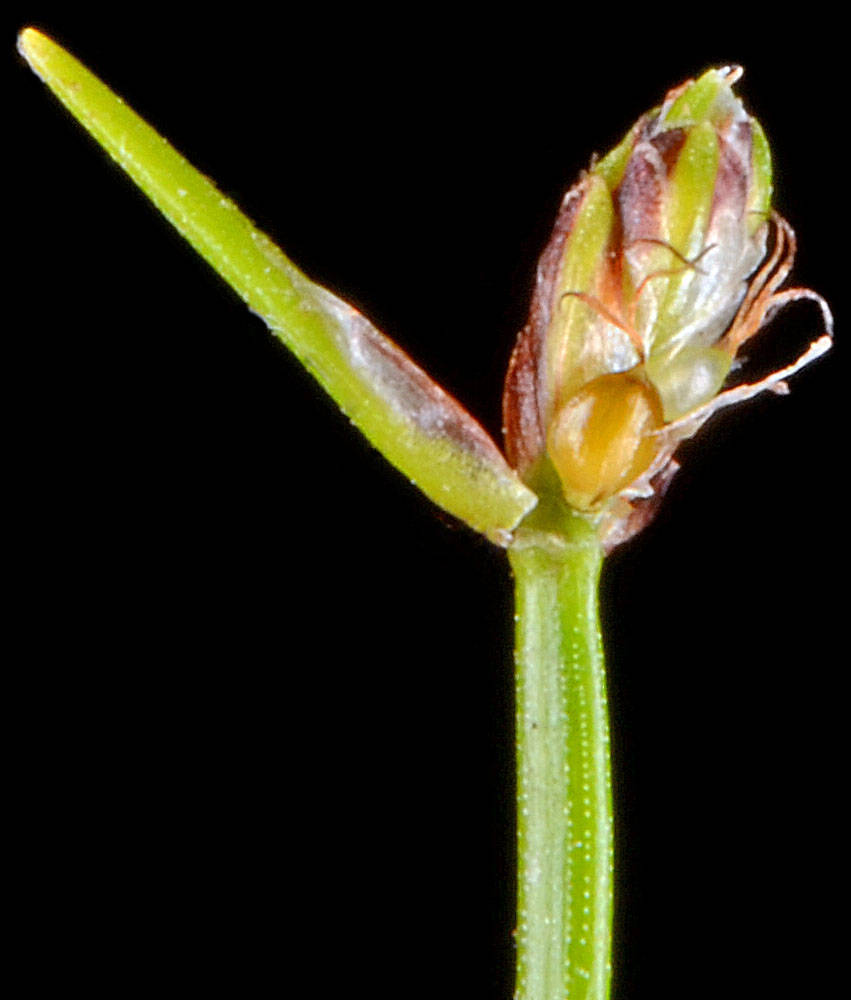Isolepis cernua
Isolepis
low clubrush
bulrush
4–40 cm × 0.2–0.5 mm.
terete.
sometimes sparsely orange-punctate at 10–15×;
distal blade rudimentary to much longer than sheath, often exceeding culm; to 20 cm × 0.2–1 mm.
all basal;
sheaths usually reddish proximally;
ligules absent;
blades rudimentary to exceeding culms.
involucral bract 1, usually erect, sometimes subtending flower or resembling enlarged floral scale, 2–6(23) mm.
terminal but usually apparently lateral because involucral bract is erect;
spikes 1–3(15);
involucral bracts 1(2); more or less erect; leaf-like.
2–5 × 1–2 mm;
proximal floral scales to 2 mm long; other floral scales 1.2–1.8 × 1–1.3 mm.
floral scales 8–25, spirally arranged; each subtending a flower.
anthers 0.3–0.6 mm.
bisexual;
perianth absent;
stamens 1–3;
styles linear;
base persistent, sometimes slightly enlarged;
stigmas 3 or mixed 2 and 3.
ellipsoid to obovoid, compressed-trigonous to thickly biconvex;
lateral angles usually prominent; dorsal angle prominent to obscure, 0.8–1 × 0.5–0.7 mm long; medium to dark brown or stramineous, distinctly papillose at 10–15× to obscurely papillose at 40×, often with thin whitish surface layer.
falling separately from the scales; biconvex or both biconvex and trigonous, papillose or longitudinally ribbed.
=30.
Isolepis cernua
Isolepis
Wet sites on beaches, ocean bluffs, and deflation plains among sand dunes. 0–50 m. Est. CA, WA; north to British Columbia, south to Mexico; South America; Africa, Australia, Eurasia, New Zealand. Native.
Isolepis cernua is variable, and several varieties have been named. Were these varieties accepted, only I. c. var. cernua would occur in North America.
Cosmopolitan in cool-tropical and temperate areas. 69 species; 2 species treated in Flora.
Isolepis is a recent segregate from Scirpus. The plants are small, more or less cespitose, with pseudolateral, sessile inflorescences and narrowly linear leaves that resemble the culms.
Barbara Wilson, Richard Brainerd, Nick Otting
Barbara Wilson, Richard Brainerd, Nick Otting
- Local floras:
BC,
CA,
OR,
WA
- Local Web sites:
CalFlora,
CalPhotos,
Flora NW,
PNW Herbaria
WildflowerSearch
iNaturalist (observations)
USDA Plants Database
- LBJ Wildflower Center
- SEINet
- Plants of the World Online
- Encyclopedia of Life
- Wikipedia
- Google Image Search
- Local floras:
CA,
OR,
WA
- Local Web sites:
CalFlora,
CalPhotos,
Flora NW,
PNW Herbaria
WildflowerSearch
iNaturalist (observations)
USDA Plants Database
- LBJ Wildflower Center
- SEINet
- Plants of the World Online
- Encyclopedia of Life
- Wikipedia
- Google Image Search



